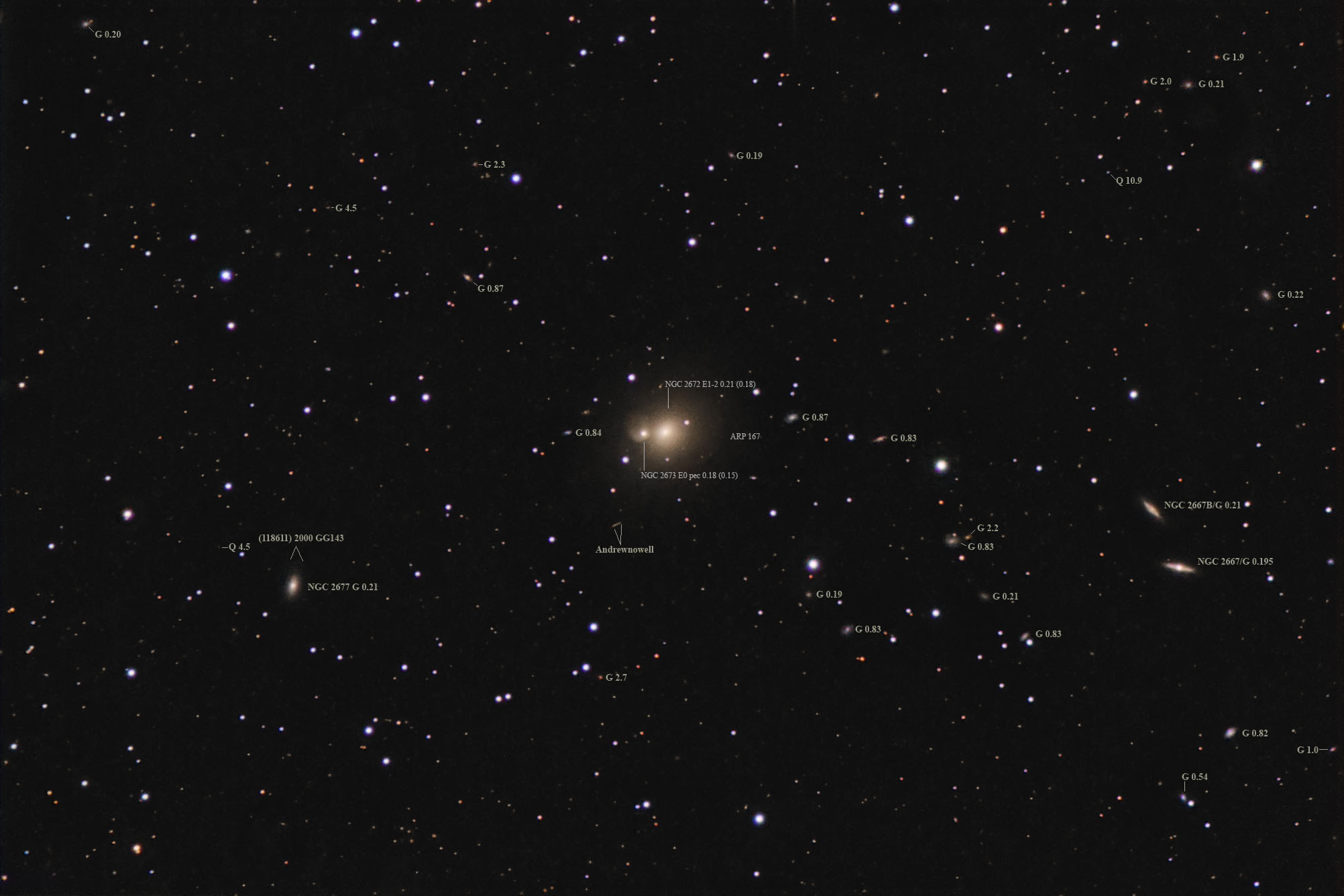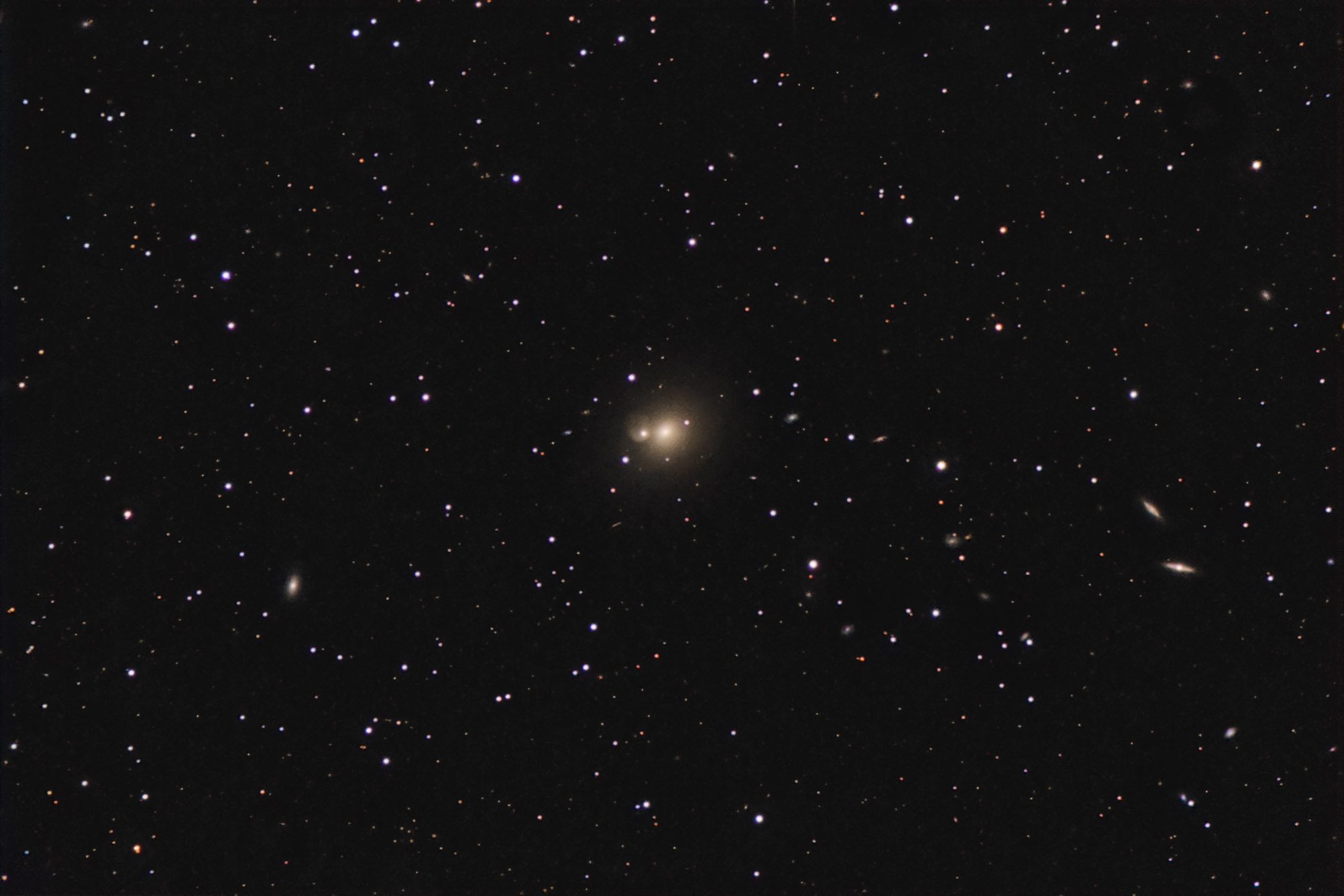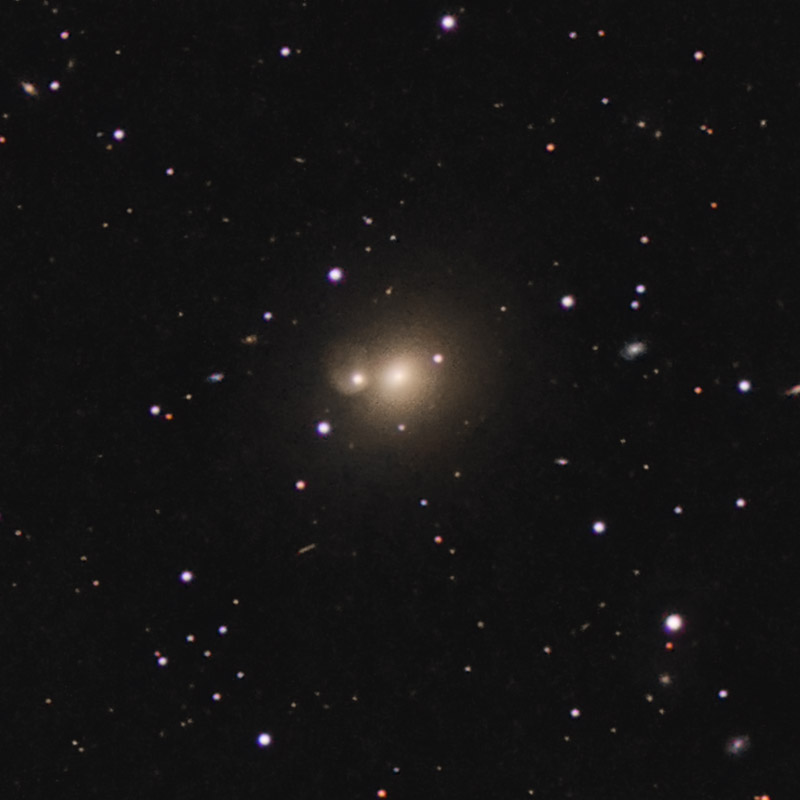Object name: ARP167Designation(s): ARP167, NGC2667, NGC2677B, NGC2672, NGC2673, NGC2677, Arp 167 is a pair of interacting galaxies located in Cancer, just east of M44, at a distance of about -- Houston we have a problem. There seems to be some uncertainty about these two galaxy's distance.
The two galaxies are NGC 2672 and NGC 2673 right to left. NED classes them as E1-2 and E0 pec respectively. Arp put them in his class of Galaxies with Diffuse Counter-tails saying; "Companion galaxy very condensed, has curved plume." NGC 2672 was discovered by William Herschel on March 14, 1784. It isn't in either Herschel 400 observing program. NGC 2673 was discovered by George Stoney on December 19, 1849.
Now back to the problems. While I called them interacting galaxies some papers say they are non-interacting. I see two reasons for this. First only NGC 2673 seems distorted. You'd think if they really did interact NGC 2672 would show some sign of it but I don't see any. The other reason is the redshift distances are different. By redshift, NGC 2672 is about 211 million light-years distant while NGC 2673 about 185 million light years. Relative speed in a galaxy group, however, can vary by this much and more. So it could be they had a fast interaction due to their high relative speeds. Still, you have the problem of NGC 2672's lack of apparent distortion. Yet most sources do consider them interacting and one puts them both at a distance of about 167 million light-years using the D-Sigma method. See http://adsabs.harvard.edu/abs/1994AAS...185.5217G for more on how this works for elliptical galaxies. Does it work for peculiar ones? Or was this just a measurement of NGC 2672 and NGC 2673 was assumed to be the same distance? I can't tell from the abstract. For now, I'll say they are interacting as I don't see any other candidate for the distortion. A large galaxy can survive such an interaction without much distortion.
The two spindle galaxies on the right (west) side of the image are NGC 2667/IC 2410 (lower) and NGC 2667B/IC 2411 (upper) at 195 and 211 million light years. About the same as the two galaxies in Arp 167. Obviously, these two aren't interacting. NGC 2667 was discovered by Heinrich d'Arrest on February 18, 1862. It was later photographed along with IC 2411 by Max Wolf on January 13, 1901 and given its IC number. Due to an error in position by d'Arrest, it wasn't realized these were the same galaxy until after the NGC was released. NGC 2677, to the southeast (lower left) of Arp 167 is the other major galaxy in the image. It splits the difference at 206 million light years. It was discovered by John Herschel on March 17, 1831. Certainly, these are all part of the same group.
Zwicky shows a galaxy cluster centered about 7 minutes south-southwest of Arp 167 with over 250 members and a distance of about 200 million light years. It covers an area almost 2 degrees across so goes far outside of my frame. It is listed as UGCl 131/ZwCl 0846.3+1910.
I've provided an annotated image showing distances to (G) Galaxies and (Q) Quasars. As usual, the label is to the immediate right of the object when possible. A line points to the object when it might not be obvious. The quasar east of Arp 167 appears elongated north/south and not a point source. NED gives two SDSS designations for it, one labeled quasar (main one) and a second one labeled galaxy though the quasar designation is the default one. It's about the same distance as a much brighter galaxy so seems dim for a quasar. I've given it a Q label as that is NED's preferred designation. It looks more like a galaxy to me. Compare it to the far more distant but brighter quasar to the northwest of Arp 167 at nearly 11 billion light years.
There are two asteroids in the image. The bright one is just southeast of Arp 167 and is named (23153) Andrewnowell and is at an estimated magnitude 19.1. The dedication for its name reads: "Andrew John Nowell (b. 1988) was awarded first place in the 2007 Intel International Science and Engineering Fair for his electrical and mechanical engineering project. He attends the Nottingham High School, Nottingham, England." The other one is hiding in the north end of NGC 2677. It is (118611) 2000 GG143 shining at an estimated magnitude 20.0.
Arp's image:
http://ned.ipac.caltech.edu/level5/Arp/Figures/big_arp167.jpeg
14" LX200R @ f/10, L=4x10' RGB=2x10'x3, STL-11000XM, Paramount ME Related Designation(s):2MASS J08482726+1901099, 2MASS J08492188+1904297, 2MASS J08492418+1904274, 2MASS J08500134+1900351, 2MASX J08482721+1901098, 2MASX J08492189+1904298, 2MASX J08500133+1900354, ARP 167, ARP 167 NED01, ARP 167 NED02, ARP167, ASK 587859.0, ASK 587901.0, CGCG 0845.6+1912, CGCG 0846.5+1916, CGCG 0846.5+1916 NED01, CGCG 0846.5+1916 NED02, CGCG 0847.2+1912, CGCG 090-016, CGCG 090-019, CGCG 090-019 NED01, CGCG 090-019 NED02, CGCG 090-021, ECO 05449, ECO 05886, ECO 06104, EON J132.114+19.020, GALEXASC J084827.24+190109.8 , HDCE 0497 NED001, HDCE 0497 NED002, HOLM 098A, HOLM 099, HOLM 099A, HOLM 099B, IC 2410, KPG 175, KPG 175A, KPG 175B, LDCE 0595 NED001, LDCE 0595 NED002, MCG +03-23-007, MCG +03-23-010, MCG +03-23-011, MCG +03-23-012, NGC 2667, NGC 2667A, NGC 2672, NGC 2673, NGC 2677, NGC2667, NGC2672, NGC2673, NGC2677, NGC2677B, NPM1G +19.0193, NPM1G +19.0194, NSA 105415, NSA 105419, NSA 135510, NSA 156910, NVSS J084921+190430, PGC 024741, PGC 024790, PGC 024792, PGC 024821, SDSS J084827.24+190110.1, SDSS J084827.24+190110.2, SDSS J084827.25+190110.1, SDSS J084827.25+190110.2, SDSS J084921.87+190429.9, SDSS J084924.19+190427.4, SDSS J084924.19+190427.5, SDSS J085001.32+190035.1, SDSS J085001.33+190035.2, UGC 04619, UGC 04620, USGC U192 NED05, USGC U192 NED06, USGC U192 NED08, UZC J084827.3+190110, UZC J084921.9+190429, UZC J085001.3+190035, WBL 196-003, [DZ2015] 647-01, [DZ2015] 647-03, [TTL2012] 398990, [TTL2012] 399081, [TTL2012] 399096, | | 

